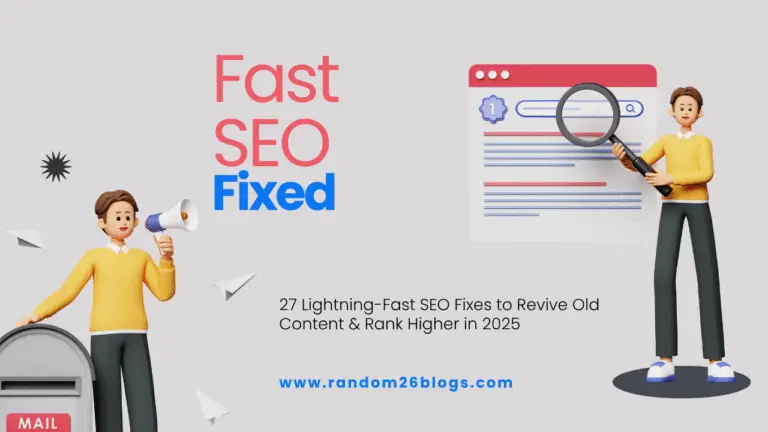
Table of Contents
Performing this type of review can seem overwhelming, but it’s crucial for driving growth in traffic and rankings. In just 120 minutes, you can pinpoint critical gaps in your website’s performance and create an actionable roadmap to success. This guide will walk you through the process step-by-step, covering technical SEO, on-page optimization, content analysis, off-page strategies, and user experience (UX) enhancements.
What is an SEO Audit and Why Does It Matter?
Performing this type of review can seem overwhelming, but it’s crucial for driving growth in traffic and rankingss. It covers everything from technical SEO and content quality to user experience and off-page factors.
By dedicating just 120 minutes, you can:
- Identify critical gaps in your website’s performance.
- Optimize for growth by addressing issues that block traffic and rankings.
- Develop a structured plan to enhance user experience and engagement.
Step 1: Preparation (5 Minutes)
Before diving into the audit, preparation is key.
Set Clear Objectives
Define the primary goals of the website, such as:
- Traffic growth
- Lead generation
- Sales conversions
Gather Essential Tools
Ensure you have access to the following tools:
- Screaming Frog
- Ahrefs/SEMrush
- Google Search Console
- Google Analytics
- PageSpeed Insights
- Hotjar
Preliminary Checks
- Confirm access to analytics tools and the website’s backend.
- Understand client-specific goals and challenges.
Step 2: Technical SEO (25 Minutes)
Technical SEO ensures your site is crawlable, indexable, and error-free—the foundation of strong search engine performance.
Crawl Your Website (10 Minutes)
Use Screaming Frog or a similar tool to:
- Identify broken links, redirect chains, and duplicate meta tags.
- Check canonical tags to avoid duplicate content issues.
- Highlight orphaned pages and resolve crawl depth issues.
- Verify the accuracy of the robots.txt file and XML sitemap.
Core Web Vitals (8 Minutes)
Analyze performance using PageSpeed Insights or Lighthouse:
- Largest Contentful Paint (LCP): Optimize load times for key elements.
- First Input Delay (FID): Ensure fast interactivity.
- Cumulative Layout Shift (CLS): Fix shifting page elements.
Indexing, Security & Mobile Optimization (7 Minutes)
- Indexing: Use Google Search Console to verify correct page indexing and address issues like “Crawled – currently not indexed.”
- Security: Confirm HTTPS implementation and resolve mixed content errors.
- Mobile Optimization: Use Google’s Mobile-Friendly Test to ensure responsive design and usability.
Step 3: On-Page SEO (20 Minutes)
On-page SEO focuses on optimizing content structure and targeting user intent.
Keyword Optimization (10 Minutes)
- Analyze title tags, meta descriptions, and headings for relevant keywords.
- Fix keyword cannibalization by assigning unique keywords to each page.
- Ensure natural keyword density and avoid stuffing.
Content Structuring (5 Minutes)
- Use H1, H2, and H3 tags to create a clear content hierarchy.
- Add schema markup for FAQs or featured snippets.
- Prioritize readability with shorter paragraphs and bullet points.
URL Structure (2 Minutes)
- Ensure URLs are concise, descriptive, and keyword-rich.
- Organize content using a logical hierarchy.
Schema Markup Validation (3 Minutes)
- Validate structured data using Google’s Rich Results Test for breadcrumbs, FAQs, and product schema.
Step 4: Content Audit (20 Minutes)
Content is the backbone of your website. This step ensures it’s engaging, relevant, and aligned with user needs.
Review Existing Content (10 Minutes)
- Identify top-performing pages and opportunities for updates.
- Highlight thin, outdated, or duplicate content.
- Align content with intent stages: TOFU (awareness), MOFU (consideration), and BOFU (decision).
Content Gap Analysis (5 Minutes)
- Use Ahrefs/SEMrush to identify missing topics or subtopics.
- Analyze competitor content to uncover additional opportunities.
Media Optimization (5 Minutes)
- Compress images to improve load times.
- Add descriptive, keyword-rich alt text to images.
- Ensure videos load efficiently without slowing the site.
Step 5: Off-Page SEO (20 Minutes)
Your website’s authority depends on external factors like backlinks and local SEO.
Backlink Audit (10 Minutes)
- Use Ahrefs/SEMrush to review referring domains for relevance and authority.
- Disavow toxic backlinks and assess anchor text distribution for risks.
Competitor Analysis (5 Minutes)
- Analyze competitors’ backlink profiles to identify link-building opportunities.
- Benchmark their domain authority and linking strategies.
Local SEO (5 Minutes)
- Audit Google Business Profile and ensure NAP (Name, Address, Phone) consistency.
- Explore local link-building opportunities, such as community sites or sponsorships.
Step 6: User Experience (15 Minutes)
Even with perfect SEO, poor UX can drive visitors away. Optimize for usability.
Design and Navigation (5 Minutes)
- Test desktop and mobile versions for logical menu structures.
- Ensure clear CTAs (calls-to-action) and intuitive navigation.
Page Interactivity (5 Minutes)
- Use Hotjar to analyze user behavior and identify pain points.
Step 7: Conversion Rate Optimization (20 Minutes)
Maximize the potential of your traffic by improving conversions.
Funnel Analysis (10 Minutes)
- Use Google Analytics to trace user flows.
- Identify high drop-off pages and address barriers.
Landing Page Optimization (5 Minutes)
- Add compelling headlines, social proof, and urgency elements.
- Remove distractions and ensure clear CTAs.
Form Usability (5 Minutes)
- Test forms for clarity and responsiveness.
- Fix error messaging and remove unnecessary fields.
Step 8: Reporting & Recommendations (15 Minutes)
Present your findings in a clear, actionable format.
Create an Actionable Plan (10 Minutes)
Prioritize tasks into:
- Quick Wins: Fix broken links, update titles, improve speed.
- Mid-Term Goals: Enhance content, improve UX, target new keywords.
- Long-Term Strategies: Build quality backlinks and scale CRO experiments.
Visual Reporting (5 Minutes)
- Use tools like Google Slides or Canva for a concise, visually appealing summary.
- Include screenshots, graphs, and next-step recommendations.
Final Tips for a Successful SEO Audit
- Focus on high-priority tasks that align with KPIs.
- Leverage competitor analysis to uncover hidden opportunities.
- Always provide long-term, scalable recommendations.
With this structured 120-minute SEO audit, you’re well-equipped to outrank your competition and set the stage for sustainable growth.






